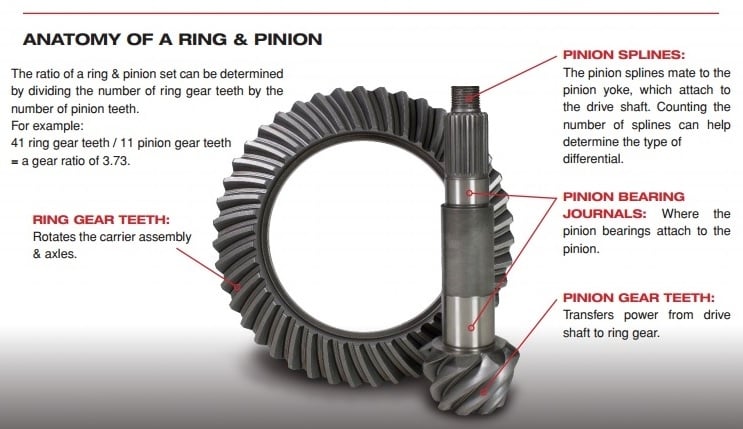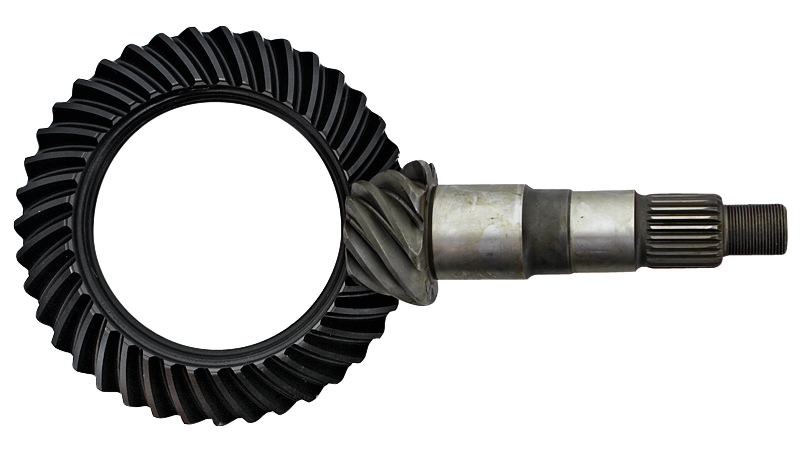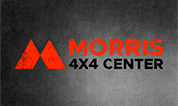What Ring and Pinion Should I Get for More Power on my Jeep?

When talking power, part of what you really want, especially for trailing, or rock crawling, is torque. It's not so much about creating torque or horsepower, but how to to use what you have effectively. Let's take a look at what kind of options you might have, and if, or when you may want to change your gear ratio to get the most out of your driving style, and your Jeep.
What are ring and pinions? What do they do? Just to go over some basics, before we get to deep into anything, let's cover a few details about ring and pinions. The axle housing, both front and rear (if you have 4WD), have a ring and pinion gear setup. Essentially these gears transfer the power from the engine to the wheels, through gears. The pinion gear lines up with the engine, transmission, and driveshafts. The gear on the end of the pinion transfers that rotating motion (and energy) onto another gear that's rotating the same direction as the wheels. You're not just transferring the motion and energy (and torque), you're carrying it from one rotating direction to another, basically at a 90 degree angle. The gears line up like the image below. The pinion gear is the one on the end of the shaft, the ring gear is the larger circular one. You've probably seen images like this on our site for companies such as Yukon Gear & Axle, or Alloy USA.

When talking ring & pinions, you'll always be referring to their (gear) ratios. For instance, a ratio might be called: 4:10, (or 5:13, or 3:73). The numbers can also be shown as: 4:10:1 and so on. What does the number tell you? It comes down to how many times the pinion gear and the ring gear are turning (rotating) and how many teeth they may have. For instance, if you have a ring and pinion gear set handy, you can calculate the ratio by counting the ring gear, and dividing it by the number of teeth on the pinion. If the ring gear has 36 teeth, and the pinion has 8, you get a ratio of: 4:5. Another way to look at it is that every time the ring gear rotates (with the tire so to speak), the pinion gear has rotated 4:5 times. You're actually multiplying your energy and torque through this motion. A rough calculation can be done to give you an idea of how the torque and gear ratios are related. Let's say you have an engine that puts out 200 ft lbs of torque (out the driveshaft from the transmission). Let's use our ratio from calculation from above, 4:5. Multiply the torque times the ratio: 200 x 4.5 = 900 ft lbs. Now you have a figure of the power that's been multiplied through the drivetrain and the ring and pinion. (of course, you need an accurate torque spec from your engine to be accurate on the calculation). Now you see where a higher gear (like a 5:13) is good for going slow, such as rock crawling. It's applying more torque to the tires / axles, which is needed. Where as, on a lower gear ratio, say a 2:73 (which is good for highway driving), you'll get much less power (200 x 2:73 = 546).
 Now we've come full circle to the basic question: What ring and pinion should I get for more power on my Jeep? While some folks will shoot from the hip and do what their "Uncle Harry" or their favorite drinking buddy might do, with the calculation information above, you should be able to come up with an acceptable ratio based on your Jeep's tech specs. We also recommend using high quality ring and pinion sets like the ones we carry here at the Morris 4x4 Center. But before you just go with the numbers, ask yourself:
Now we've come full circle to the basic question: What ring and pinion should I get for more power on my Jeep? While some folks will shoot from the hip and do what their "Uncle Harry" or their favorite drinking buddy might do, with the calculation information above, you should be able to come up with an acceptable ratio based on your Jeep's tech specs. We also recommend using high quality ring and pinion sets like the ones we carry here at the Morris 4x4 Center. But before you just go with the numbers, ask yourself: - What kind of driving are you doing? - The 5:13 gears may give you great torque at the Saturday Trails or Rock Event, but do you drive your Jeep everyday 70 miles to get to work? You'll be running some high RPMs to achieve highway speeds, and you can forget about gas mileage.
- Do you have a baseline of horsepower and torque specs to calculate with? - You need accurate information to do the calculations. While you probably can't be exact on the numbers, you don't want have a 4-cylinder engine putting out 75 hp and expect to crank out a lot of torque at the wheels, with any ratio, like a V8 Jeep would. Keep that in mind.
- Tire size - The tire size ( or rather, the height ) only marginally effects the numbers. For instance, if you have a 16 inch tire, or a 33 inch tire, the ration is the same at the axles (at the end of the axle where the tire bolts on): a 4:5 gear works the same - every time the ring gear rotates (with the tire so to speak), the pinion gear has rotated 4:5 times. People ask about tire size because it takes more power, more torque to rotate a 33 inch tire, not to mention that it's a lot heavier weight wise. While there's no exact calculation I know of, you typically need more torque to turn the larger tire, but you still need the calculation (above) to know what ratio to use based on available horsepower and torque from your engine (and your driving needs of course).
- Yukon gear & Axle
- Alloy USA
- Spicer
- MOPAR
- Omix




